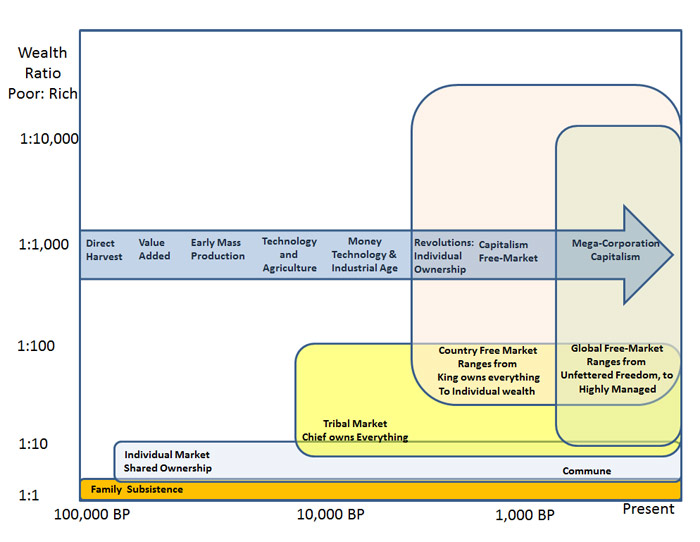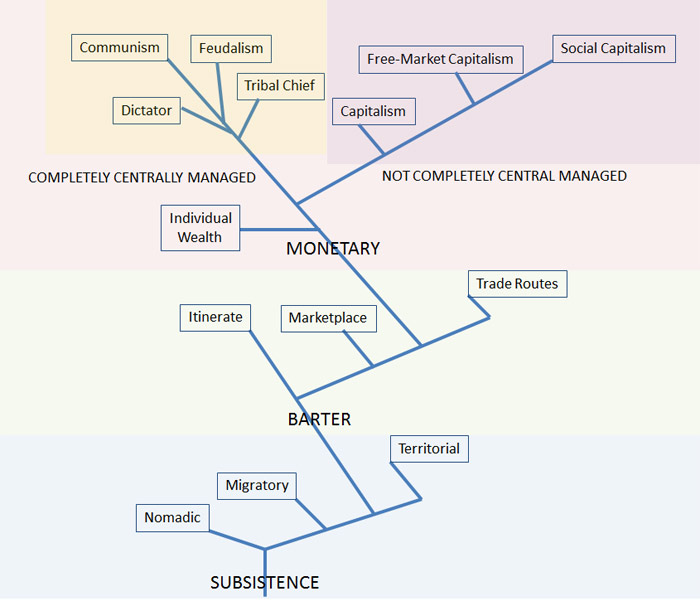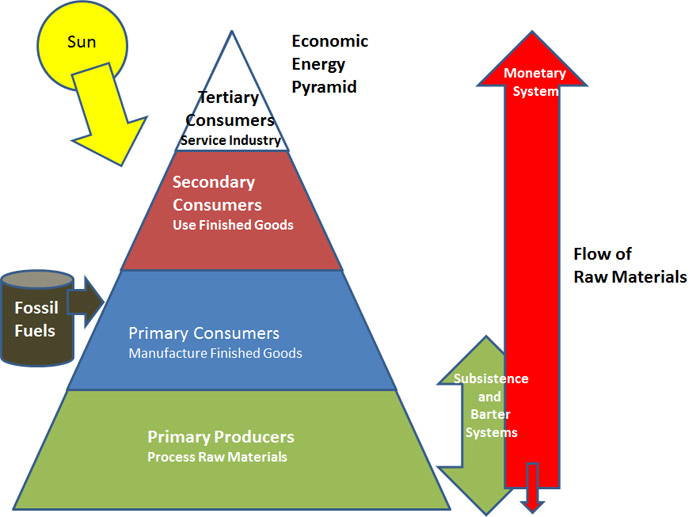Let me recap the thinking so far. Economic evolution is a spontaneous undirected long-term process, stretching back at least 100,000 years. The process is one in which each type of economic system gradually developed. The next new system sprang from the previously existing species. The actual historical record of the times for the ancient evolutionary events are not easy to define, but archaeological evidence might suggest a shift from subsistence to bartering sometime about 70,000 years ago. Shortly after that it is likely that the earliest mass production of tools or tool parts began. As the trade become more intensely developed based on bartering, someone no doubt thought about representing a purchase so that it could be “ordered” and delivered later. Money and monetary systems probably were pretty well established at about the time the shift from nomadic, semi-nomadic, and migratory life styles intensified the agricultural aspects with a shift to primarily monetary systems perhaps 10,000 years ago. Massive accumulations of wealth by chiefs and rulers became too repressive for peaceful acceptance by the general population. Revolutions reduced the incidence of feudalism and dictatorships, allowing the potential for individual ownership. Although economic evolution still proceeds, just like biological evolution, it is too slow for us to see it happen in a lifetime.

I hypothesize three main lineages (Lucrephyla), subsistence, barter, and monetary. Two major branches of the monetary lineage (Lucreclasses) include the completely centrally controlled systems in which there is either no or very limited individual ownership, and a second system in which the individual can own property and accumulate wealth with varying degrees of state intervention — capitalism.
In a capitalist system, only entrepreneurs are part of the wealth exchange equation. Everyone else is either not in the system or is used as an expendable resource. In a centrally controlled system, everyone is included in the equation as part of the need to plan the production and distribution of processed goods and products from the processed goods. Although money is used in this system, only limited wealth is allowed outside the controlling group. Within each of these major classes, there are subgroups. In capitalism for example there are varying degrees of power exercised by government to redistribute wealth gained by the entrepreneurs to the rest of the people in the system.
As in biological systems, economic evolution takes place in a context. In biological systems we term this context to be ecological. Ecosystems are also self-generating spontaneous processes that are not designed or directed. There are no predefined species or ecosystems, they happen in a blind undirected way. We can observe them and try to understand them, even manage them to a degree. Our description of ecosystems is based on a model that interprets the flow of energy through the system trophic. Each level of energy transfer is termed a trophic level. They are familiar in biology as primary producers, herbivores (primary consumers) and then predators (secondary, tertiary and more consumers). If we take the biological metaphor, there are similar activities going on in economic systems. Here we define primary producers as entrepreneurs who transform raw materials into processed materials. The next level is primary consumers who use the processed materials (similar to herbivores) and then secondary and tertiary consumers (similar to various levels of predators in nature). The equivalent to organisms that recycle (decomposers, scavengers, detritivores, etc.) are the various similar garbage collectors, recyclers and government agencies that redistribute the monetary wealth. In planned economies, the wealth is distributed to everyone on a formula basis, whereas in socialistic capitalist systems it is distributed out of the entrepreneurial wealth exchange to the rest of the people by taxes. A pure free market would not have taxes and the infrastructure would only be developed as corporations saw necessary. In a free-market system, individuals who are not entrepreneurs or employees are either supported by families and volunteers or starve to death. Economic systems in comparison to biological systems are very simple and not very efficient.
There are many thousands ecosystems in the world, just as there are many economic equivalents of ecosystems in the world. The many types of ecosystems and the many species of organisms tend to exhibit patterns depending on where they are in the world and the conditions in which they operate. These basic patterns of assemblages in biology are called biomes. An equivalent pattern is observable in economic systems. I have chosen to call these economes for ease of comparison. The main variables that can be used to encompass most of the variation in economic patterns are latitude, biological cover and other resources, and built or created infrastructure. It is important to remember that an econome is more than a single economic system, such as capitalism. An econome, like a biome encompasses the entire set of ecosystems or economic equivalents from subsistence to bartering to the top level system in any given region. In some areas, the underground or shadow economy, as well as the illicit economies are a big factor in the productivity or richness of an econome.
Here are the main observed economes in the world:
| Tropical desert/mountain not terraformed | Poor or non-utilized resource base | Yemen |
| Tropical desert/mountain terraformed | Single or limited resource base such as oil or mineral | United Arab Emirates |
| Tropical forest not terraformed | Generally rich resource base either not used or few value-added exports | Belgian Congo |
| Tropical forest terraformed | Rich resource base used internally with value-added local infra-structure | Brazil |
| Temperate forest not terraformed | Generally rich resource base either not used or few value-added exports | Parts of Siberia |
| Temperate forest terraformed | Rich resource base used internally with value-added local infra-structure | United States of America |
| Temperate desert/mountain not terraformed | Poor or non-utilized resource base | Lesotho |
| Temperate desert/mountain terraformed | Single or limited resource base such as oil or mineral | Switzerland |
Evolution, species, ecosystems all have parallels in economy. To be able to understand how an economic system works using these parallels, it is important to get it right. Hayek and Friedman did not get it right. The consequences from their fundamental lack of understanding of the principles of biology has wrought huge suffering on many people and has and continues to misdirect the planning and management of much economic strategy.
Before going to the next stage in this thought experiment on comparing biology and economy, I want to underscore some important principles. Both the economic and the biological processes are spontaneous, non-directed, mindless processes. There is no predestined set of species or lucrespecies that will evolve. There is no predetermined form of an economic system, it is just what develops in response to the selective forces around the system.
Have you ever seen a species?
No, you haven’t, you have only seen individuals from that species. So a species is a concept, not a physical thing. We know it exists because we have examples of individuals from the species we describe. The same is true of economic species. We know they exist because we can see examples of individual entrepreneurs or corporations that fall into easily described categories. We know biomes and economes exist because the simple variables associated with the names describe most of the variation seen in the patterns. The next question is whether the models we have been developing are predictive. If they are, can they also be used to develop coping strategies. Unlike ecosystems, it will not be easy to manage an economic equivalent because we are inside the system, not outside it.


